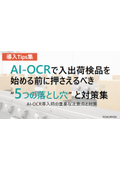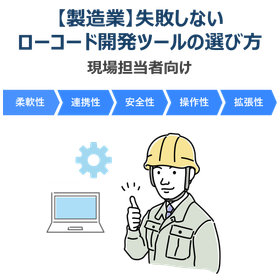Requirements Definition Guide for Successful Implementation of AI-OCR Inspection System
AI-OCR/Inbound and Outbound Shipping/Inspection/Inventory/Requirements Definition
Preventing "This wasn't supposed to happen..."! A collection of preemptive measures to promote inspection DX that won't trouble the field.
■ Overview This document is a guide that systematically organizes the "Requirements Definition Checklist (15 items in total)" that must be understood when implementing an AI-OCR-based inspection system for inbound and outbound shipments. To prevent common failures in system implementation, it categorizes points to be checked from the initial consideration phase to "Current Situation Analysis" and "System Integration," explaining them visually and clearly. ■ Features - The structure is divided into four major categories (Current Situation Analysis, Scale/Capacity, Quality/Accuracy, System Environment), allowing for an overview of the implementation process. - It covers questions relevant to the field, such as monthly processing volume, types of labels, network environment, and integration methods. - Each item's details, background, and key points to consider are explained thoroughly. - By using this checklist, it is possible to smoothly advance on-site hearings and internal organization towards the implementation of the AI-OCR inspection system.
Inquire About This Product
basic information
■Table of Contents - AI-OCR Inbound and Outbound Inspection System Implementation Requirements Definition Checklist - Why This Document is Necessary (Background) - Intended Audience (Business Personnel, IT Personnel, Implementation Responsible Person) - Common Failure Examples - Overview of Requirements Definition Checklist - Details of Requirements Definition Checklist
Price range
Delivery Time
Applications/Examples of results
Utilization as a document for organizing and discussing requirements when introducing the AI-OCR inspection system 【Main Uses】 - Utilized for initial discussions and issue organization in internal projects → Used as a base document for the team to visualize the current state and issues of the inspection process and organize the feasibility of alternatives with AI-OCR. - Used as a tool for sharing requirements with the information systems department → Can be utilized as a common framework to clearly communicate what the responsible department needs to consider and where to organize. - Preparation material for meetings and requirement hearings with vendors → By organizing and sharing the hearing content based on a checklist, it helps prevent oversight and discrepancies in understanding, thereby enhancing the accuracy of the implementation. - Attached as supporting material for approval documents and proposals → Can be used as supplementary material to structurally explain to management and superiors why this implementation is necessary for investment decisions.
catalog(3)
Download All CatalogsCompany information
Tokei Densan was established in 1970 as an SI company born from the computing division of Tokyo Roki Co., Ltd., a manufacturer of automotive parts. Initially focused on the development, operation, and maintenance of ERP products for automotive parts manufacturers, it now develops products and services specialized for various industries and business operations, not limited to manufacturing. Our department (Manufacturing Systems Sales Department) is the oldest division within Tokei Densan and is a crucial part of our revenue foundation. Since its inception, it has consistently provided outsourcing and original system construction services to manufacturing customers, growing alongside the times and advancements in technology. In particular, for our main users, automotive functional parts manufacturers, we have continuously provided systems incorporating the latest technologies for over 30 years. The rich technology and know-how cultivated in this area are still utilized in system construction for a diverse range of customers, regardless of their business type or size. In 2012, we established a local subsidiary in Thailand, the center of ASEAN where Japanese companies are increasingly expanding, to support the development and implementation of business systems, primarily focusing on sales management and accounting systems, for local Japanese companies.









![[No Rib Specification] Tsubaki Plastic Modular Chain RN Specification](https://image.mono.ipros.com/public/product/image/33f/2001047735/IPROS21984474667709120944.png?w=280&h=280)




